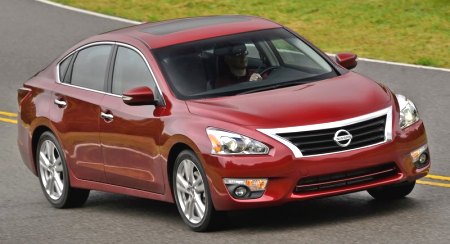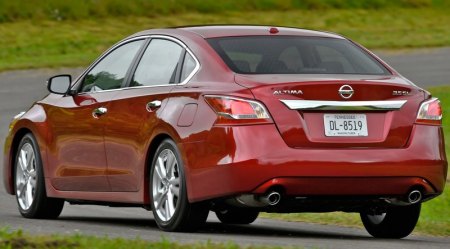|
|
|
| Published
on 5
Jun
2012 |
All rights reserved.
|
|

The
mid-size family car
segment in the USA is so huge and profitable that Toyota, Honda and
Nissan can build Camry, Accord and Altima exclusively for the market
yet maintain a short, 5-year model changeover cycle. In the past 21
years, Nissan sold some 3.8 million units of Altima there over 4
generations, and the trend is rising. Last year, it rose to the
runner-up position just behind Camry, thanks partly to the supply issue
of Honda. This year, the battle is expected to be more intense, because
most of its rivals are either due for replacement or have already been
renewed. These include Chevrolet Malibu, Honda Accord and in particular
Ford Fusion / Mondeo. Fortunately, the Altima has also entered the next
generation.
In terms of styling, the new Altima does not break any new ground,
unlike Hyundai Sonata, Kia Optima / K5 or the forthcoming Fusion. Its
designers try very hard to make it stylish and different, but the
result is hardly convincing. It trades the simplicity of the last two
generations for a more complex, heavily twisted body shape, which
unfortunately has signs of influence by Chris Bangle's flame surface
theme like many other designs these days. The idea is to make it more
flowing, more dynamic when the car is moving under light reflection,
but in photos its shape is hard to define. Moreover, the expressive
headlights and taillights look arbitrary, while the new grille looks
uncomfortably close to that of Lexus. All these factors mean the new
Altima is hard to recognize.

Exterior dimensions are more or less the same as before. It gets only
35 mm longer and 35 mm wider. Wheelbase stands at 2775 mm, while
overall height is unchanged. As expected, the new body shell employs
more than 50 percent high-strength steel to cut weight. In addition to
aluminum bonnet and bumper reinforcement the car's kerb weight is
reduced by 36 kg, claimed Nissan. Meanwhile, a larger front tower brace
and a rear structural support built into the parcel shelf should
improve chassis rigidity. Outside, by adding air deflectors and
underbody panels, Cd drops from 0.31 to 0.299.
Underneath the body shell, the underpinning platform is an evolution of
the existing D platform, whose roots can be traced back to the FF-L
platform of the 2001 model. It continues to ride on MacPherson struts
up front and a multi-link setup at the rear. However, there are plenty
of improvements. For example, classy Sachs dampers have been adopted to
improve ride quality, while the rear suspensions have revised geometry
to allow passive rear-wheel steering, so to stabilize the car at
high-speed bends. The wider body shell also accommodates wider tracks
front and rear. A brake-actuated torque vectoring has been added to
cut understeer. Up front, old-fashioned hydraulic power steering has
been
upgraded to electrohydraulic assistance – surprisingly, not pure EPS.
No wonder it loads up naturally.
On the road, the Altima feels sportier than the class norm. Its
suspension tuning is taut without punishing in ride quality. Body
control is remarkable, and the steering is precise and responsive, so
the car is willing to be pushed. There is a slight torque steer on the
more powerful V6 model, but it is manageable. On highway, noise level
is generally low. Flaws? The braking is pretty weak, and big bumps can
rock its structure, which doesn't feel as solid as Volkswagen Passat NA.

As before, there are two conventional engines to choose from. The
3.5-liter VQ35DE V6 with 270 hp is carried over unchanged from the old
car. It still returns the best performance of the class. However, 90
percent of buyers will opt for the cheaper QR25DE four-pot. Now it gets
dual-VVT, variable intake manifold and a regenerative
starter-alternator, along with 7 extra horsepower (182 hp in total). It
is not the smoothest four-banger around though. Keen drivers will be
disappointed with the fact that 6-speed manual gearbox is no longer
available. Now both engines are mate with a heavily modified Xtronic
CVT, whose wider ratio spread and revised control logic make it finally
a decent companion. It also allows the otherwise unremarkable engines
to register class-leading fuel economy (for non-hybrid, of course). The
only complaint is rubber-band effect still present under full-throttle
acceleration. It keeps the four-cylinder engine revving constantly at
6200 rpm, generating lots of unpleasant noise. In normal driving, the
powertrain combos are refined enough.
Inside, the new cabin looks okay rather than desirable. Most surfaces
have been upgraded to soft plastics, but the switch gears do not
operate with a smoothness and sensitivity you expect – a typical flaw
of Nissan products. On the plus side, the "NASA-inspired Zero-Gravity"
front seats are truly comfortable, relieving your fatigue by spreading
the pressure evenly. The rear seats offer good legroom, if not as
generous on headroom for tall passengers.
Overall speaking, the new Altima is no ground-breaking product.
However, it is well-rounded, offering a good combination of dynamics,
refinement, frugality and value. Keen drivers will be delighted with
its
fine handling and performance, although it doesn't look very exciting. |
Verdict:     |
Published
on 14
Jan 2015
|
All rights reserved.
|
|
Teana
|
|

|
After 2 generations as an
independent model, Teana becomes a rebadged version of Altima. The
reason is obvious: Nissan sells 300,000 Altimas in the USA every year,
versus 80,000 to 90,000 Teanas in China and only 2,000 to 3,000 Teanas
in Japan. This makes the business case of Teana hard to justify. The
straightforward solution is to merge it with Altima,
considering that they are close in size and already shared many
underpinnings. Unfortunately, the merger means it has to sacrifice the
quality interior of the old car and shares the much cheaper one with
Altima. The exterior design is also less
elegant than executive car buyers would like. As a result, it is likely
to lose some buyers.
Mechanically, the Teana is basically the same as the Altima installed
with 2.5-liter QR25DE four-cylinder engine and Xtronic CVT, but it is
detuned to 173 horsepower. Sadly, it no longer offers a V6 engine. In
China, you can buy an entry-level model with 140 hp MR20DE engine.
From these combinations you can see its market positioning has been
lowered. In other words, it is no longer the Teana we used to know.
|
Verdict:    |
|
|
|
|
|
|
|
|
|
|
Altima 2.5
|
2012
|
Front-engined,
FWD
|
| Steel monocoque |
| Mainly steel |
| 4865 / 1830 / 1470 mm |
| 2775 mm |
Inline-4
|
| 2488 cc |
DOHC 16 valves, DVVT
|
| VIM |
| - |
| 182 hp |
| 180 lbft |
| CVT |
F: strut
R: multi-link
|
| - |
215/55VR17
|
| 1407 kg |
130 mph (est)
|
7.7*
|
| 21.7* |
|
Altima 3.5
|
2012
|
Front-engined,
FWD
|
| Steel monocoque |
| Mainly steel |
| 4865 / 1830 / 1470 mm |
| 2775 mm |
V6, 60-degree
|
| 3498 cc |
DOHC 24 valves, VVT
|
| - |
| - |
| 270 hp |
| 258 lbft |
| CVT |
F: strut
R: multi-link
|
| - |
235/45VR18
|
| 1522 kg |
145 mph (est)
|
6.1* / 5.7**
|
| 14.6* / 14.1** |
|
|
|
|
|
|
Performance
tested by: *C&D, **R&T
|
|
|
|
|
|
|
|
|
Copyright©
1997-2015
by Mark Wan @ AutoZine
|
|